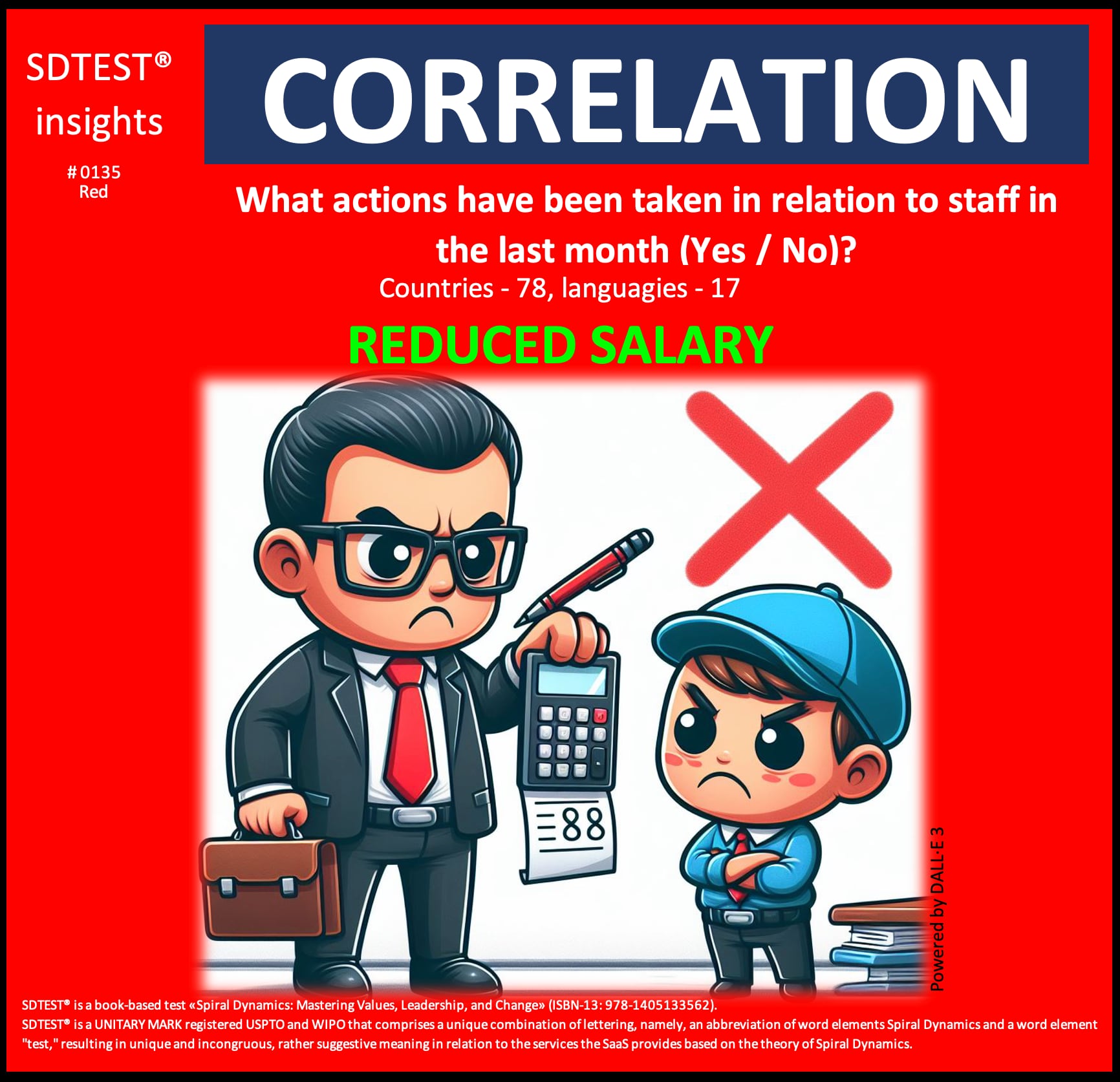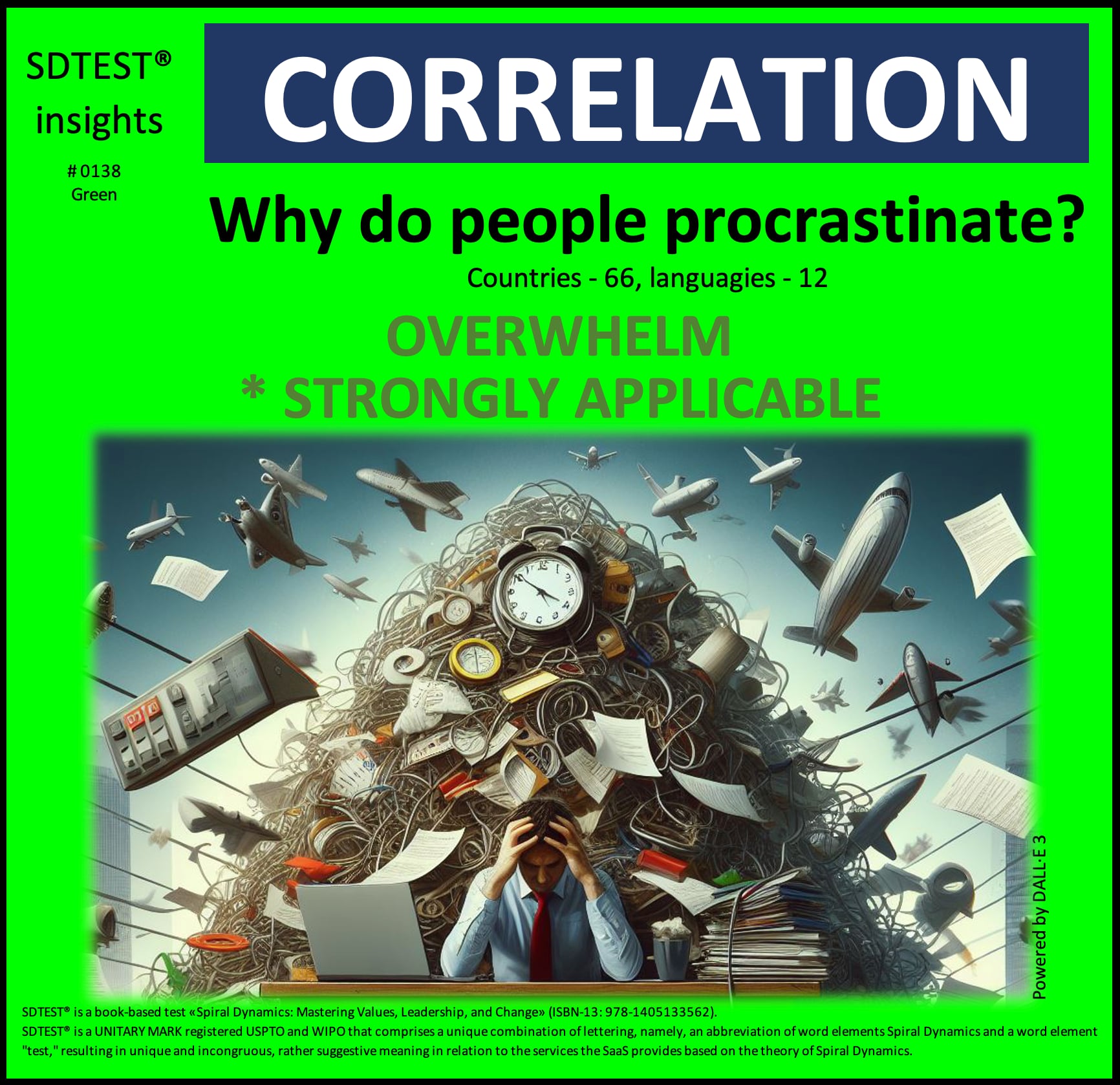Mastering Values, Leadership, and
Change» (ISBN-13: 978-1405133562)

SDTEST® has 33 different VUCA polls that calculate the 12,299 correlation values between stages of development according to the theory of Spiral Dynamics and answer options of these 33 polls.
We invite curiosity about the systemic mechanisms behind this correlation. There may be hidden variables that provide alternative explanations.
0.1539 between the Mirroring someone's feelings / Strongly Agree and the Purple stage.
The critical value of the correlation coefficient for a normal distribution, by William Sealy Gosset (Student) r = 0.0784. This positive correlation of 0.1539 meets the reliability criteria but does not necessarily imply causation.

This positive correlation of 0.1539 suggests that empathy and community are highly valued within the Purple value system and seen as essential for building strong relationships and creating a more harmonious and supportive environment. It could be explained from three points of view:
Companies operating within the Purple value system would likely view the positive correlation as an indication of the importance placed on empathy and community within their organization. These companies may recognize that mirroring someone's feelings is crucial to building strong relationships and fostering a sense of belonging among their employees. To create a more harmonious and supportive work environment, they may prioritize initiatives that promote empathy, such as team-building activities, mentorship programs, and open communication channels.
Within teams operating in the Purple value system, the positive correlation may suggest a strong emphasis on empathy and understanding among team members. Team members may be more likely to actively listen, ask questions, and seek to understand each other's perspectives, recognizing that mirroring someone's feelings is key to building trust and rapport. This team dynamic may foster a culture of open communication, where team members feel comfortable sharing their thoughts and feelings and where conflicts are resolved through constructive dialogue and compromise.
For individuals operating within the Purple value system, the positive correlation may reflect a deep understanding of the importance of empathy and community in their personal and professional lives. These individuals may view mirroring someone's feelings as a way to build strong relationships, foster a sense of belonging, and create a more harmonious and supportive environment. They may be more inclined to engage in activities promoting empathy, such as volunteering, community service, and social activism, to impact their community and the world positively.
0.0645 between the Reduced salaries and the Red stage.
The critical value of the correlation coefficient for a normal distribution, by William Sealy Gosset (Student) r = 0.057. This positive correlation of 0.0645 meets the reliability criteria but does not necessarily imply causation.

This positive correlation of 0.0645 suggests that within the Red value system, individual power and self-expression are highly valued and that the reduction of salaries may be seen as a means to assert dominance and control. It could be explained from three points of view:
Companies operating within the Red value system would likely view this positive correlation as an indication of the importance placed on individual power and self-expression. These companies may recognize that reducing salaries can be a means to assert their dominance and control over their employees and may prioritize initiatives that promote individualism and competition over collective well-being. They may be more inclined to use force or coercion to achieve their goals and view the salary reduction as a necessary step to maintain their power and influence.
Within teams operating in the Red value system, this positive correlation may suggest a strong emphasis on individual achievement and competition. Team members may be more likely to prioritize their own interests and desires over the collective good, and may be willing to use force or manipulation to achieve their goals. This team dynamic may foster a culture of dominance and submission, where individuals are likelier to engage in aggressive or competitive behavior to assert their power and influence.
For individuals operating within the Red value system, this positive correlation may reflect a deep desire for individual power and self-expression. These individuals may view the reduction of salaries as a means to assert their dominance and control. They may be more inclined to prioritize their own interests and desires over the collective good. They may be more impulsive and willing to act on their desires without considering the consequences. They may be more likely to engage in aggressive or competitive behavior to achieve their goals.
0.1568 between the Organisation's recruitment and promotion process based on personal connections, background, or other factors and the Blue stage.
The critical value of the correlation coefficient for a normal distribution, by William Sealy Gosset (Student) r = 0.1443. This positive correlation of 0.1568 meets the reliability criteria but does not necessarily imply causation.

This positive correlation of 0.1568 suggests that within the Blue value system, tradition, order, and hierarchy are highly valued and that the merit-based system may threaten the established order. It could be explained from three points of view:
Companies operating within the Blue value system would likely view this positive correlation as an indication of the importance placed on tradition, order, and hierarchy. These companies may recognize that a merit-based system can threaten the established order and prioritize initiatives that promote loyalty, duty, and responsibility over individual achievement. They may be more inclined to use personal connections, background, or other factors to determine recruitment and promotion, as this aligns with their values of tradition, order, and hierarchy.
Within teams operating in the Blue value system, this positive correlation may suggest a strong emphasis on loyalty, duty, and responsibility. Team members may be more likely to prioritize the team's and the organization's needs over individual achievement. They may be more inclined to follow a strict hierarchy and code of conduct. This team dynamic may foster a culture of conformity, where individuals are likelier to adhere to established rules and norms, and individual creativity and innovation are seen as threats to the established order.
For individuals operating within the Blue value system, this positive correlation may reflect a deep sense of duty and responsibility. These individuals may be more likely to follow a strict code of conduct and judge others who do not conform to their beliefs. They may also be more likely to prioritize tradition, order, and hierarchy over individual creativity and innovation.
-0.2656 between the People are encouraged to assert themselves and the Orange stage.
The critical value of the correlation coefficient for a normal distribution, by William Sealy Gosset (Student) r = 0.1823. This negative correlation of -0.2656 meets the reliability criteria but does not necessarily imply causation.

This negative correlation of -0.2656 highlights the complexities of balancing assertiveness with individualism and self-reliance within the Orange value system. It could be explained from three points of view:
This negative correlation suggests that companies within the Orange value system may face challenges in aligning assertiveness with the value of individualism and self-reliance. While the Orange value system typically values independence and self-reliance, this negative correlation indicates that the encouragement to assert oneself may not effectively foster the desired traits of individualism and self-reliance. Companies may need to reevaluate their approach to promoting a culture that balances assertiveness with autonomy, ensuring that individuals feel empowered to take the initiative and drive their own success within the organization.
Within teams operating in the Orange value system, this negative correlation may signal a potential conflict between encouraging assertiveness and promoting individualism. Team members may find it challenging to assert themselves while maintaining a sense of independence and self-reliance. This dynamic could lead to difficulties in collaboration and teamwork as individuals navigate the balance between asserting their ideas and respecting the autonomy of others. To address this, teams may need to foster a culture that values both assertiveness and independence, emphasizing effective communication, mutual respect, and collaborative problem-solving.
For individuals within the Orange value system, this negative correlation may reflect a tension between asserting one's opinions and upholding the value of independence and self-reliance. Individuals may need to find a harmonious balance between expressing themselves assertively and maintaining their autonomy. Developing strong communication skills, active listening, and a collaborative mindset can help individuals navigate this balance effectively, ensuring that they can contribute assertively while respecting the perspectives and contributions of their peers.
0.0850 between the Overwhelm: Feeling overwhelmed by the magnitude or complexity of a task, leading to delayed action / Strongly Applicable and the Green stage.
The critical value of the correlation coefficient for a normal distribution, by William Sealy Gosset (Student) r = 0.0771. This positive correlation of 0.0850 meets the reliability criteria but does not necessarily imply causation.

This positive correlation of 0.0850 suggests that within the Green value system, the well-being of the community and the environment is highly valued, and that feeling overwhelmed by the magnitude or complexity of a task can negatively impact this well-being. It could be explained from three points of view:
Companies operating within the Green value system would likely view this positive correlation as an indication of the importance placed on community and ecology. These companies may recognize that feeling overwhelmed by the magnitude or complexity of a task can lead to delayed action, which can negatively impact the well-being of the community and the environment. They may prioritize initiatives promoting unity, cooperation, and sustainability and develop strategies to help employees manage their workload and reduce feelings of overwhelm.
Within teams operating in the Green value system, this positive correlation may suggest a strong emphasis on collaboration and mutual support. Team members may be more likely to work together to manage their workload and reduce feelings of overwhelm, recognizing that the team's well-being is closely tied to the well-being of the community and the environment. This team dynamic may foster a culture of open communication, active listening, and mutual respect, where team members feel comfortable sharing their concerns and working together to find solutions.
For individuals operating within the Green value system, this positive correlation may reflect a deep concern for the community's well-being and the environment. These individuals may view feeling overwhelmed by the magnitude or complexity of a task as a sign that they are taking on too much and may prioritize their own well-being and the well-being of those around them. They may be more inclined to seek help and support from others and may be more likely to prioritize their own needs and boundaries to maintain their own well-being.
-0.3146 between the When I feel ANGRY. I will pause until I am able to think clearly so l can respond rationally instead of reacting / Strongly Disagree, and the Yellow stage.
The critical value of the correlation coefficient for a normal distribution, by William Sealy Gosset (Student) r = 0.1975. This negative correlation of -0.3146 meets the reliability criteria but does not necessarily imply causation.

This negative correlation of -0.3146 between "When I feel ANGRY. I will pause until I am able to think clearly so I can respond rationally instead of reacting / Strongly Disagree" and the Yellow stage indicates that the higher the level of Yellow, the less agreement there is with the "Strongly Disagree" response.
Therefore, if there is less agreement with "Strongly Disagree", it logically follows that there is more agreement with the original statement: "When I feel ANGRY. I will pause until I am able to think clearly so I can respond rationally instead of reacting."
In summary, the higher the level of Yellow, the more individuals agree with pausing when angry to respond rationally instead of reacting impulsively.
It could be explained from three points of view:
For companies within the Yellow value system, this negative correlation indicates that companies valuing the Yellow system may prioritize emotional regulation and thoughtful responses over-reactive behavior. They may implement strategies to promote mindfulness, emotional intelligence, and conflict resolution within the workplace to foster a culture of rational and composed reactions, enhancing team dynamics and productivity.
Within teams in the Yellow value system, the negative correlation implies that as the team's alignment with the Yellow stage strengthens, there is less inclination to strongly disagree with pausing when angry to respond rationally. This suggests that teams tend to value emotional self-regulation and thoughtful responses over impulsive reactions. Team members may be encouraged to develop skills in emotional intelligence, active listening, and collaborative problem-solving to enhance team cohesion and effectiveness. Emphasizing a culture of understanding and rational communication can improve team dynamics and performance.
For individuals embodying the Yellow value system, this negative correlation indicates that as their Yellow level increases, there is a decreased likelihood of strongly disagreeing with the statement about pausing when angry to respond rationally. This suggests that individuals at higher Yellow levels are more inclined to value emotional composure and rational responses in challenging situations. They may prioritize personal growth in emotional intelligence, self-awareness, and conflict resolution to navigate interactions effectively. By embracing a mindset of reflection and thoughtful action, individuals can contribute personally and professionally to a more harmonious and productive environment.
-0.1592 between the Inattention to Results (A team that doesn't focus on results will quickly find itself adrift) and the Turquoise stage.
The critical value of the correlation coefficient for a normal distribution, by William Sealy Gosset (Student) r = 0.1424. This negative correlation of -0.1592 meets the reliability criteria but does not necessarily imply causation.

This negative correlation of -0.1592 suggests that as the level of Turquoise increases, the likelihood of inattention to results decreases.
It could be explained from three points of view:
Companies operating within the Turquoise value system would likely view this negative correlation as an indication of the importance placed on holistic, integrated, and ecological perspectives. Companies may prioritize initiatives that foster a culture of sustainability, harmony with the natural world, and a focus on the well-being of people and the planet. By emphasizing the interconnectedness of all things, companies can enhance their overall performance and contribute to a more harmonious and sustainable environment.
Within teams operating in the Turquoise value system, this negative correlation may indicate a potential conflict between the desire for results and the need for holistic, integrated, and ecological perspectives. Team members may find it challenging to balance their focus on results with the need to consider the broader implications of their actions on the environment and society. To address this, teams may need to develop strategies that integrate their focus on results with their commitment to sustainability and harmony with the natural world. This could involve incorporating environmental and social impact assessments into their decision-making processes and prioritizing initiatives that promote the well-being of both people and the planet.
For individuals operating within the Turquoise value system, this negative correlation may reflect a deep concern for the interconnectedness of all things and the need for holistic, integrated, and ecological perspectives. These individuals may view inattention to results as a sign of a lack of understanding of this and the need for a more comprehensive approach to decision-making. They may prioritize personal growth in emotional intelligence, self-awareness, and conflict resolution to navigate interactions effectively and contribute to a more harmonious and sustainable environment.
What insights do you gain from today's correlation? How might we study this relationship more carefully before deducing causation?
We welcome respectful and wise perspectives! Stay tuned every week as we share more results and insights.
After login or registration, free access to the poll results in the FAQ section.
[1] https://www.linkedin.com/in/nawal-mustafa-84a90591/, https://www.instagram.com/thebraincoach/
